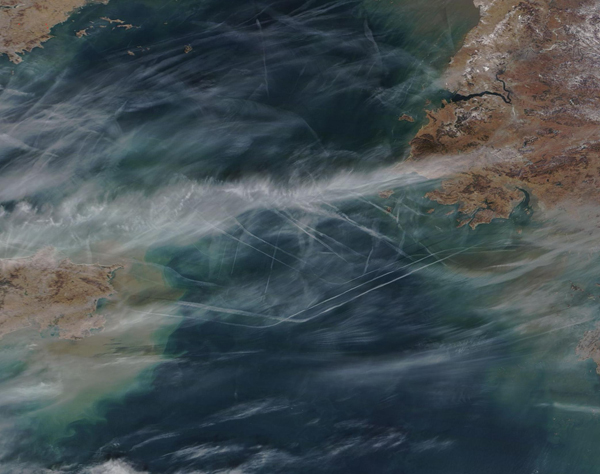Images
January 26, 2020 - Contrails over the Yellow Sea
Tweet
The numerous types of clouds that grow and move around Earth are constantly shaped by the atmosphere, land, and ocean. They can even be shaped by human activity.
Condensation trails, or contrails, are a type of cloud that forms in nearly the same way as naturally occurring cirrus clouds. At high altitudes, where it’s cold enough—at least -39°C (-38°F)—water vapor can easily freeze onto small particles in the atmosphere and form clouds. When the phenomenon involves particles from the exhaust of aircraft, the resulting long, narrow cloud is categorized as a contrail.
On January 24, 2020, the Moderate Resolution Imaging Spectroradiometer (MODIS) on board NASA’s Terra satellite acquired a true-color image of the skies over the Yellow Sea.
The atmosphere in this region often wears a veil of haze and cloud. On this particular day, the colors of sediment in the blue water, sweeping strokes of cloud across the sky, especially between China (east) and North Korea), and haze created a complex scene. And the picture became even more complex with numerous contrails crisscrossing the sky over the Yellow Sea.
Each contrail marks the passage of an aircraft in the busy skies. Many of the contrails are parallel, suggestive of a common flight path. The numerous angles speak to the number of flight paths used by planes to travel to various destinations. The pair of long contrails that line up roughly on an east-west axis may well be made from planes traveling between China’s Weihai airport and Seoul, South Korea. Multiple parallel lines situated on a northwest-to-southeast axis may well be marking the path of planes leaving from Dalian Zhoushuizi International Airport. Dalian is located in Liaoning Province China, close to the land visible in the northwest corner of the image.
Image Facts
Satellite:
Terra
Date Acquired: 1/2/2020
Resolutions:
1km (155.4 KB), 500m (404.5 KB), 250m (680.3 KB)
Bands Used: 1,4,3
Image Credit:
MODIS Land Rapid Response Team, NASA GSFC
Tweet
The numerous types of clouds that grow and move around Earth are constantly shaped by the atmosphere, land, and ocean. They can even be shaped by human activity.
Condensation trails, or contrails, are a type of cloud that forms in nearly the same way as naturally occurring cirrus clouds. At high altitudes, where it’s cold enough—at least -39°C (-38°F)—water vapor can easily freeze onto small particles in the atmosphere and form clouds. When the phenomenon involves particles from the exhaust of aircraft, the resulting long, narrow cloud is categorized as a contrail.
On January 24, 2020, the Moderate Resolution Imaging Spectroradiometer (MODIS) on board NASA’s Terra satellite acquired a true-color image of the skies over the Yellow Sea.
The atmosphere in this region often wears a veil of haze and cloud. On this particular day, the colors of sediment in the blue water, sweeping strokes of cloud across the sky, especially between China (east) and North Korea), and haze created a complex scene. And the picture became even more complex with numerous contrails crisscrossing the sky over the Yellow Sea.
Each contrail marks the passage of an aircraft in the busy skies. Many of the contrails are parallel, suggestive of a common flight path. The numerous angles speak to the number of flight paths used by planes to travel to various destinations. The pair of long contrails that line up roughly on an east-west axis may well be made from planes traveling between China’s Weihai airport and Seoul, South Korea. Multiple parallel lines situated on a northwest-to-southeast axis may well be marking the path of planes leaving from Dalian Zhoushuizi International Airport. Dalian is located in Liaoning Province China, close to the land visible in the northwest corner of the image.
Image Facts
Satellite:
Terra
Date Acquired: 1/2/2020
Resolutions:
1km (155.4 KB), 500m (404.5 KB), 250m (680.3 KB)
Bands Used: 1,4,3
Image Credit:
MODIS Land Rapid Response Team, NASA GSFC




